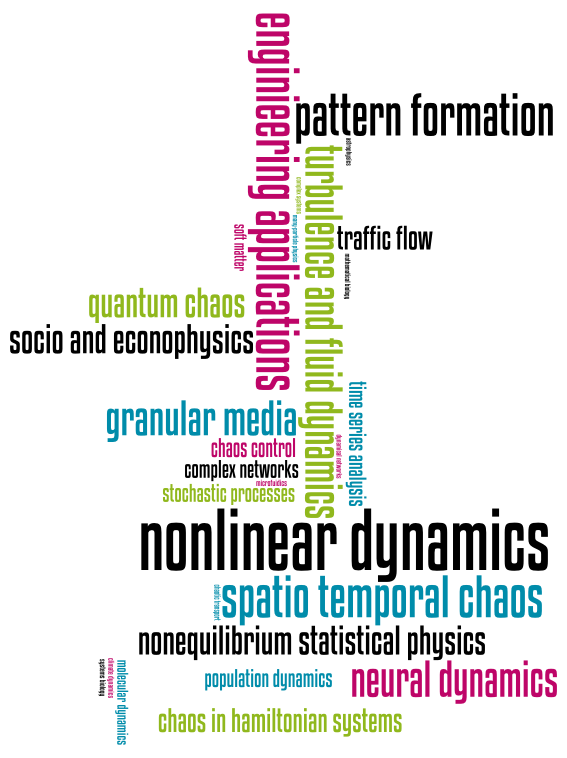|
|
Albert-Lázló Barabási, Northeastern University (USA)
Taming Complexity: Controlling Networks [collapse abstract]
The ultimate proof of our understanding of biological or technological systems is reflected in our ability to control them. While control theory
offers mathematical tools to steer engineered and natural systems towards a desired state, we lack a framework to control complex
self-organized systems. Here we develop analytical tools to study the controllability of an arbitrary complex directed network, identifying the set of driver nodes whose time-dependent control can guide the system's entire dynamics. We apply these tools to several real networks,
finding that the number of driver nodes is determined mainly by the network's degree distribution. We show that sparse inhomogeneous
networks, which emerge in many real complex systems, are the most difficult to control, but dense and homogeneous networks can be
controlled via a few driver nodes. Counterintuitively, we find that in both model and real systems the driver nodes tend to avoid the hubs.
|
|
|
Hugues Chaté, Centre d'Etudes de Saclay (France)
Importance of nonlinear features in continuous theories of active matter [collapse abstract]
After a general introduction to the statistical physics approach to active matter/collective motion, I will outline how controlled continuous theories can be derived from
simple systems of self-propelled particles akin to the celebrated Vicsek model. Investigating the properties of the obtained nonlinear PDEs, I will stress the role and
importance of their inhomogeneous solutions in describing many of the collective phenomena observed in the original particle-based systems.
|
|
|
Anne Ly Do, MPI for the Physics of Complex Systems Dresden (Germany)
Meso-scale structures induce characteristic instabilities in networks of coupled dynamical systems [collapse abstract]
The dynamics of networks of interacting systems depend intricately on the interaction topology. Dynamical implications of local topological
properties such as the node degrees and global topological properties such as the degree
distribution have intensively been studied. Meso-scale properties, by contrast, have only recently come into sharp focus of network science but
developed rapidly into one of the hot topics in the field. Current questions are: Can
considering a meso-scale structure such as a single subgraph already allow conclusions on dynamical properties of the network as a whole?
Can we extract implications that are independent of the embedding network? And, which meso-scale
structures should be considered? Here, we show that certain meso-scale subgraphs have precise and distinct consequences for the system-level
dynamics. In particular, they induce characteristic dynamical instabilities that are independent of the structure of the embedding network.
|
|
|
Mitchell J. Feigenbaum, The Rockefeller University (USA)
Title TBA [collapse abstract]
|
|
|
Jordi García-Ojalvo, Universitat Pompeu Fabra (Spain)
Quantifying gene-circuit dynamics at the single-cell level [collapse abstract]
Cellular processes rely on the coordinated activity of multiple
genes and proteins linked together in regulatory circuits.
Understanding cellular processes requires a global view
of these circuits at the system level. In that scenario,
theoretical models become an absolute necessity in order to
comprehend cellular behavior. Since the experimental values of
most model parameters are unknown, it is imperative to validate
the models by performing a quantitative comparison between
experiments and theory. Here we show how such a comparison can
be undertaken in a systematic way, using bacterial stress response
as a case example. Our results also show how dynamics plays
a crucial role in allowing for this quantitative approach to
cellular physiology.
|
|
|
Susanna C. Manrubia, Centro de Astrobiología CSIC-INTA (Spain)
Evolution on genotype networks leads to phenotypic entrapment [collapse abstract]
The relationship between genotype and phenotype is many-to-many. In particular, genotypes encoding a particular phenotype form vast, connected networks that often span the whole space of possible genotypes. Regarding their
topological properties, genotype networks are highly heterogeneous in degree and, in most know cases, assortative (as in RNA and proteins). These properties have important effects on the dynamics of populations evolving on genotype
networks. In this contribution we demonstrate that, as time elapses, the probability that a population visits nodes of increasingly higher degree augments. In evolutionary terms, this implies that the probability that a population
changes phenotype depends in a non-trivial way on the time the population has maintained its current phenotype. We derive a mathematical theory that explicitly quantifies this phenotypic entrapment and explicitly shown the dependence
on measurable quantities such as network size, mutation rate, or fitness of the phenotype. Numerical simulations of dynamics on RNA genotype networks are used to illustrate the phenomenon and the predictive power of the theory.
|
|
|
Cristina Masoller, Universitat Politécnica de Catalunya (Spain)
Distinguishing Signatures of Determinism and Stochasticity in
Spiking Complex Systems [collapse abstract]
I will present a method to infer signatures of determinism and
stochasticity in the sequence intensity dropouts of a semiconductor
laser with optical feedback, which resemble neuronal spikes. The
method uses ordinal time-series analysis to classify
inter-dropout-intervals (IDIs) in two categories that display
statistically significant different features, one being consistent
with waiting times in a resting state until noise triggers a dropout,
and the other, with dropouts occurring during the return to the
resting state, which has a certain deterministic component.
The method can be used for the analysis of real-world data, such as neuronal
recordings of inter-spike intervals (ISIs), or data generated by
complex systems such as inter-event times of user activity in social
communities, where signatures of deterministic underlying dynamics can
be obscured by the presence of noise. The method is computationally simple to implement and the
data requirements can be adapted to the analysis of small and large
data sets.
|
|
|
Luciano Pietronero, University of Rome "La Sapienza" (Italy)
A new metrics for the economic complexity of countries and products
[collapse abstract]
Measuring intangible nonmonetary values is a crucial element in economics because its comparison with the monetary performance can reveal new information on the hidden potential of a country which is the fundamental element for future growth. Here we consider the COMTRADE dataset which provide the matrix of countries and their exported products. According to the standard economic theory the specialization of countries towards certain specific products should be optimal. The observed data show that this is not the case and that diversification is actually more important. Specialization may be the leading effect in a static situation but the strongly dynamical globalized world market suggests instead that flexibility and adaptability are essential elements of competitiveness as in biosystems. The crucial challenge is then how to turn these qualitative observations into quantitative variables. We introduce a new metrics for the Fitness of countries and the Complexity of products which corresponds to the fixed point of the iteration of two nonlinear coupled equations. The nonlinearity is crucial because it represents the fact that the upper bound on the Complexity of a product is given by the less developed country that can produce it. This and other differencies make our metric completely different from the one of Hidalgo and Haumann who first tried to address this question. We discuss the conceptual and practical advantages of our approach which represents a concrete tool for a realistic and testable description of these ideas. The information provided by the new metrics can be used in various ways. The direct comparison of the Fitness with the country GDP gives an assessment of the non expressed potential of the country. This can be used as a predictor of GDP or stock index. The global dynamic shows, however, a large degree of heterogeneity which implies that countries which are in a certain zone of the paramenter space evolve in a predictable way while others show a chaotic behavior. This heterogeneous dynamic is also outside the usual economic concepts. It is also possible to evaluate risk and compare it with the standard ratings. Finally this new approach may be interesting for planning of the industrial development of a country.
|
|
|
Itamar Procaccia, Weizmann Institute of Science (Israel)
Mechanism of Dissipation in Turbulent Quantum Fluids at Ultra Low Temperatures [collapse abstract]
At very low temperatures, for example below 1 degree Kelvin for Helium, the classical viscosity is practically zero.
Yet, preparing a state of flow it becomes turbulent and it decays in time. I will discuss the physical mechanisms that are
responsible for this inviscid dissipation: weak turbulence of Kelvin waves on quantized vortex lines and sound emission during
vortex reconnection. I will stress in particular some recent progress on analytical solutions for both these mechanisms.
|
|
|
Kenneth Showalter, West Virginia University (USA)
Synchronization in Populations of Chemical Oscillators: Quorum Sensing, Phase Clusters
and Chimeras [collapse abstract]
We have studied large, heterogeneous populations of discrete chemical oscillators (~100,000) to characterize two different types of density-dependent transitions to synchronized behavior, a gradual Kuramoto synchronization and a sudden quorum sensing synchronization. We also describe the formation of phase clusters, where each cluster has the same frequency but is phase shifted with respect to other clusters, giving rise to a global signal that is more complex than that of the individual oscillators. Finally, we describe experimental and modeling studies of chimera states and their relation to other synchronization states in populations of coupled chemical oscillators.
|
|
|
Wolf Singer, MPI for Brain Research Frankfurt am Main (Germany)
Time as coding space for information processing in the cerebral cortex [collapse abstract]
Higher cognitive functions require the coordination of large assemblies of spatially distributed neurons in ever changing constellations.
It is proposed that this coordination is achieved through dynamic coordination of temporally structured activity. Since there is no supra-ordinate command centre in the brain,
the respective patterns of coherent activity need to self-organize within the fixed architecture of anatomical connections. Evidence will be provided that dynamic
coordination supports response selection by attention, subsystem integration, flexible routing of signals across cortical networks and access to the work-space
of consciousness. The precision of temporal coordination is in the millisecond range suggesting the possibility that information is encoded not only in the
co-variation of discharge rates but also in the phase relations of discharges relative to population oscillations.
This phase coding could account for the high speed with which cortical circuits can encode and process information. Recent studies in schizophrenic
patients indicate that this disorder is associated with abnormal synchronisation of oscillatory activity in the high frequency range (beta and gamma).
This suggests that some of the cognitive deficits characteristic for this disease result from deficient binding and subsystem integration.
|
|
|
H. Eugene Stanley, Boston University (USA)
The Fragility of Interdependency: Coupled Networks & Switching Phenomena [collapse abstract]
Recent disasters ranging from abrupt financial "flash crashes" and large-scale power out-
ages to sudden death among the elderly dramatically exemplify the fact that the most
dangerous vulnerability is hiding in the many interdependencies among different networks.
In the past year, we have quantified failures in interconnected networks, and demonstrated
the need to consider mutually dependent network properties in designing resilient systems.
Specifically, we have uncovered new laws governing the nature of switching phenomena in
coupled networks, and found that phenomena that are continuous "second order" phase
transitions in isolated networks become discontinuous abrupt "first order" transitions in
interdependent networks. We conclude by discussing the network basis for under-
standing sudden death in the elderly, and the possibility that financial "flash crashes"
are not unlike the catastrophic first-order failure incidents occurring in coupled networks.
Specifically, we study the coupled networks that are responsible for financial fluctuations.
It appears that "trend switching phenomena" that we uncover are remarkably independent
of the scale over which they are analyzed.
|
|
|
Manuel G. Velarde, Universidad Alfonso X El Sabio (Spain)
Model studies of electron transfer and conduction mediated by solitons in 1D and 2D crystal lattices [collapse abstract]
First I shall present a model of soliton-like excitations in lattice chains/circuits/layers with units interacting with Morse interactions.
Then, by adding external excess electrons, using the tight binding approximation (TBA), I shall show the formation of bound states between such charges and the soliton excitations, thus defining the "solectron" quasiparticle, in a sense that generalizes the (textbook) "polaron" concept of Landau, Pekar, Fröhlich,... and the "electro-soliton" of Davydov. I shall also comment on "electron pairing" and the formation of bi-solectrons (two strongly correlated electrons in momentum space and in real space with due account of Coulomb repulsion and Pauli's exclusion principle). Adding Langevin stochastic sources to the mixed classical-quantum dynamics of the system, I shall illustrate the "long lasting" robustness and hence "practical" stability of the solectrons to moderate levels of heating (up to ambient temperature in bio-molecules). The solectron moves in general with supersonic velocity though its actual velocity depends, e.g., on the strength of electron-lattice/phonon/soliton interaction. Possible applications of the theoretical predictions include a novel form of electron transfer (ET) in polymers like poly-di-acetylene (PDA and related) crystals, synthetic DNA and Ga-As or LiNbO3 (SiO) layers.
|




